Key design parameters for accessibility such as kerb arrangements, access ramps, tactile ground surface indicators, and pedestrian movement.
The table below summarises signs and markings corresponding to each type of bus stop classification and whether the component is essential, recommended or optional.
Where items marked essential are not legislative requirements, departures should be approved by the relevant road controlling authority and public transport authority.
Table: Summary of key design parameters for accessibility
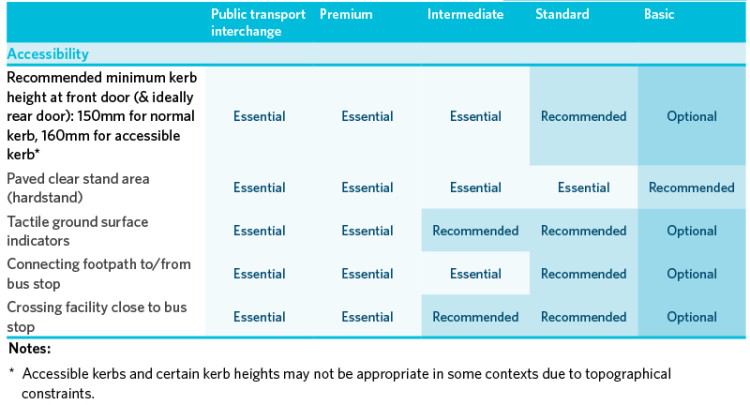
Download key design parameters for accessibility table [PDF, 219 KB]
The kerb forms a critical interface between the bus and the passenger. For a bus to dock correctly and deploy its ramp safely, kerbs should be provided as an expected minimum at all bus stops. This facilitates basic accessibility.
Kerbs at bus stops should:
Considerations for kerb arrangements (discussed next) are:
Kerbs need to be high enough to minimise the step or ramp up to the bus, while taking into account the variable ground clearance of buses.
See also:
PTDG: Accessible kerbs
Although a large proportion of New Zealand urban buses can ‘kneel’, the reduction in step height achieved by kneeling is not necessarily uniform along the side of the bus. If the kneeling system operates on the front axle alone, the front door will be lower than the centre door. Alternative kneeling configurations include tilting of the near-side of the bus or lowering of the entire vehicle.
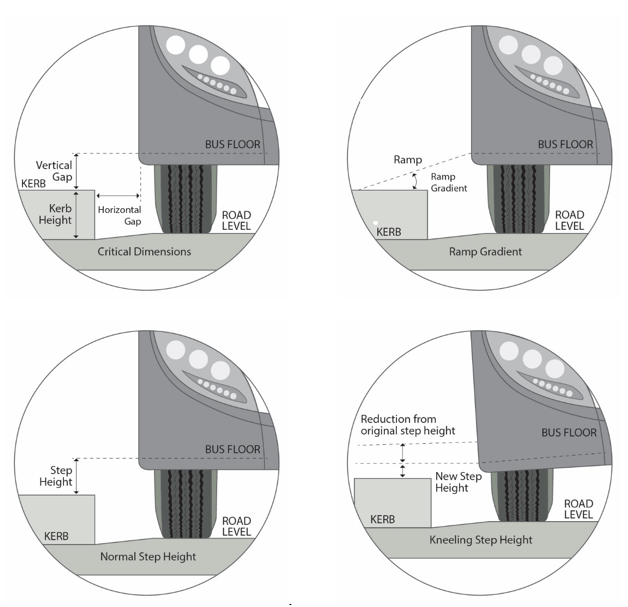
Horizontal gaps, ramp gradient and step height. (Source: Flow Transportation Specialists)
The use of higher kerbs and the transition between them need careful consideration because:
These risks can be mitigated by providing the correct bus stop layout with the correct lead-in and lead-out and appropriate driver training. However, existing bus stops with higher kerbs may not allow buses to approach correctly (for example, when road camber is severe).
Before increasing kerb heights, review the layout of each bus stop to ensure no conflict will occur. Factors to consider include the following.

Kerb and footpath damage from bus scraping associated with inadequate ground clearance (Credit: Lorelei Schmitt)
The bus stop layout should allow the bus to stop parallel to and as close to the kerb as possible. This makes it easy and safe for passengers to get on and off the bus.
The critical dimensions to consider are the:
The design should aim to minimise these two distances.
Where kerb heights are changed, consider carriageway and footpath crossfalls carefully. Footpath crossfalls should have a gradient of no more than 2% within the clear stand area, as a steep backfill from the kerb is undesirable for customer safety and comfort.
The ideal kerb arrangement should provide close vertical and horizontal alignment between the bus floor and adjacent footway.
Consider using accessible kerbs, such as Kassel kerbs (see the figure below). These kerbs have a profile to help guide the bus along the kerb edge and into a position that reduces the horizontal gap between bus and footpath without damaging the wheel and tyre.
Accessible kerbs are available in different heights with 160mm and 180mm being most common. The preferred height for a Kassel kerb is 160mm, although site-specific circumstances may mean a different height is appropriate.
Accessible kerbs of more than 160mm should be provided at bus stops only where buses always have clear, flat, unimpeded access on the approach and departure from the boarding point and no likelihood of any obstruction that would prevent the bus arriving parallel to the kerb without hitting it.
Consider accessible kerbs for:

Kassel kerb profiles. (Source: Adapted from Flow Transportation Specialists)
Consistency of user experience is very important.
Where kerb and bus door heights can be brought to within about 40mm and the bus docked close and parallel to the kerb, it should be possible for most people, including those using wheelchairs, to get on and off without using the integrated ramp (see figure below).
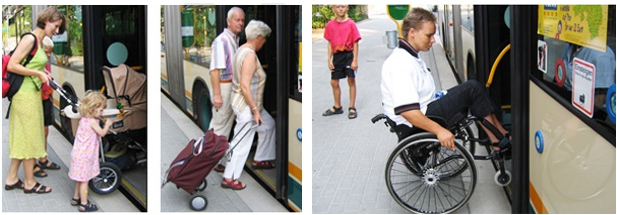
Small gaps between the kerb and bus floor make it easy for passengers to get on or off. (Source: Auckland Transport)
Where a kerb and bus door height of about 40mm cannot be achieved, it should still be possible to deploy the ramp from the front door with the bus docked close and parallel alongside the kerb (see the figure below). The key to good design is ensure bus drivers are not obliged to position the bus differently to deploy the ramp, as non-ramp users must also be able to get on and off with the bus in the same position.
The maximum gradient allowed for the step ramps formed between two horizontal surfaces is 12.5% or 1:8 (see NZS 4121:2001 and Requirement for Urban Buses).
More standards for kerb ramps are in section 4 of NZS 4121:2001.
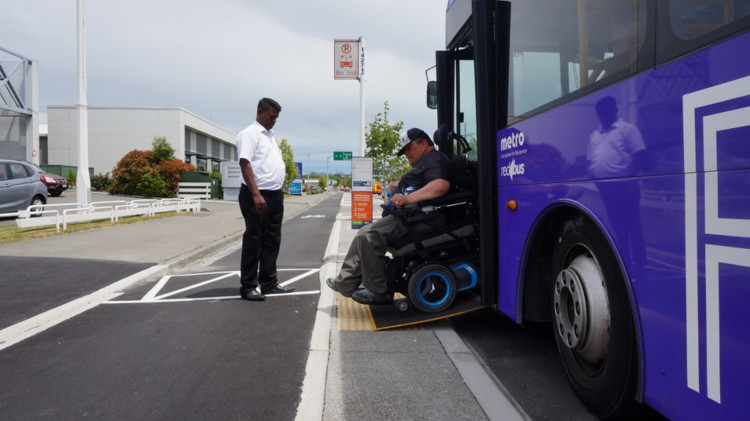
Accessible ramp. Note the narrow width of the boarding island next to the cycleway creates a conflict with the cycleway that the driver is standing on. (Credit: Brenda O’Donoghue)
The requirements for new urban buses are that wheelchairs and prams load at the front.
Wheelchair ramps of about 800mm wide and about 800mm long are fitted to all new and a large proportion of older urban buses.

Tactile ground surface indicators at a bus stop in Dunedin (Credit: Mark Edwards)
Tactile ground surface indicators provide visual and sensory information about the road environment. They assist people with vision impairments to access the bus from the adjoining footpath by warning and directing them.
RTS14 - Guidelines for facilities for blind and vision impaired pedestrians [PDF, 1.6 MB]
A recommended layout for tactile ground surface indicators at bus stops is shown in the figure below.
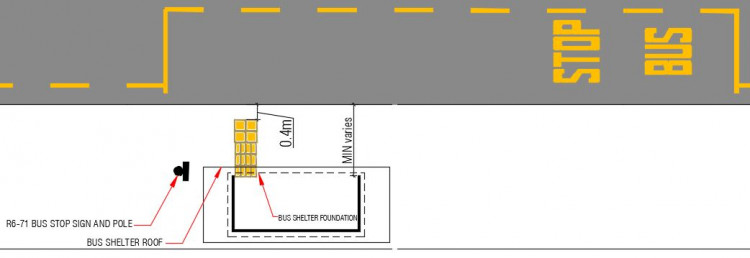
Recommended layout for tactile ground surface indicators at bus stops. (Source: Auckland Transport) View larger image [JPG, 37 KB]
Bus stop design should allow for both the safe and easy movement of pedestrians along the footpath and for an adequate waiting area for bus passengers.
Bus stops should be located where footpaths are wide enough, so waiting bus passengers do not obstruct passing pedestrians. A continuous accessible (safe, obvious, step-free) pedestrian through route of at least 1.8m, should be provided for the full length of the bus stop.
A minimum 9–10m should be paved at the bus stop box, forming a 1.8m x 9–10m (16.2–18m2) paved hardstand area free of fixed obstacles. This length of ‘landing pad’ means both bus doors have access to the hardstand. In constrained locations, a minimum footpath width of 1.5m may be acceptable.
If an existing footpath is too narrow, consider locating the bus stop where the footpath can be widened, without compromising other location criteria. This is especially important for bus stops alongside retail activity or other busy places.